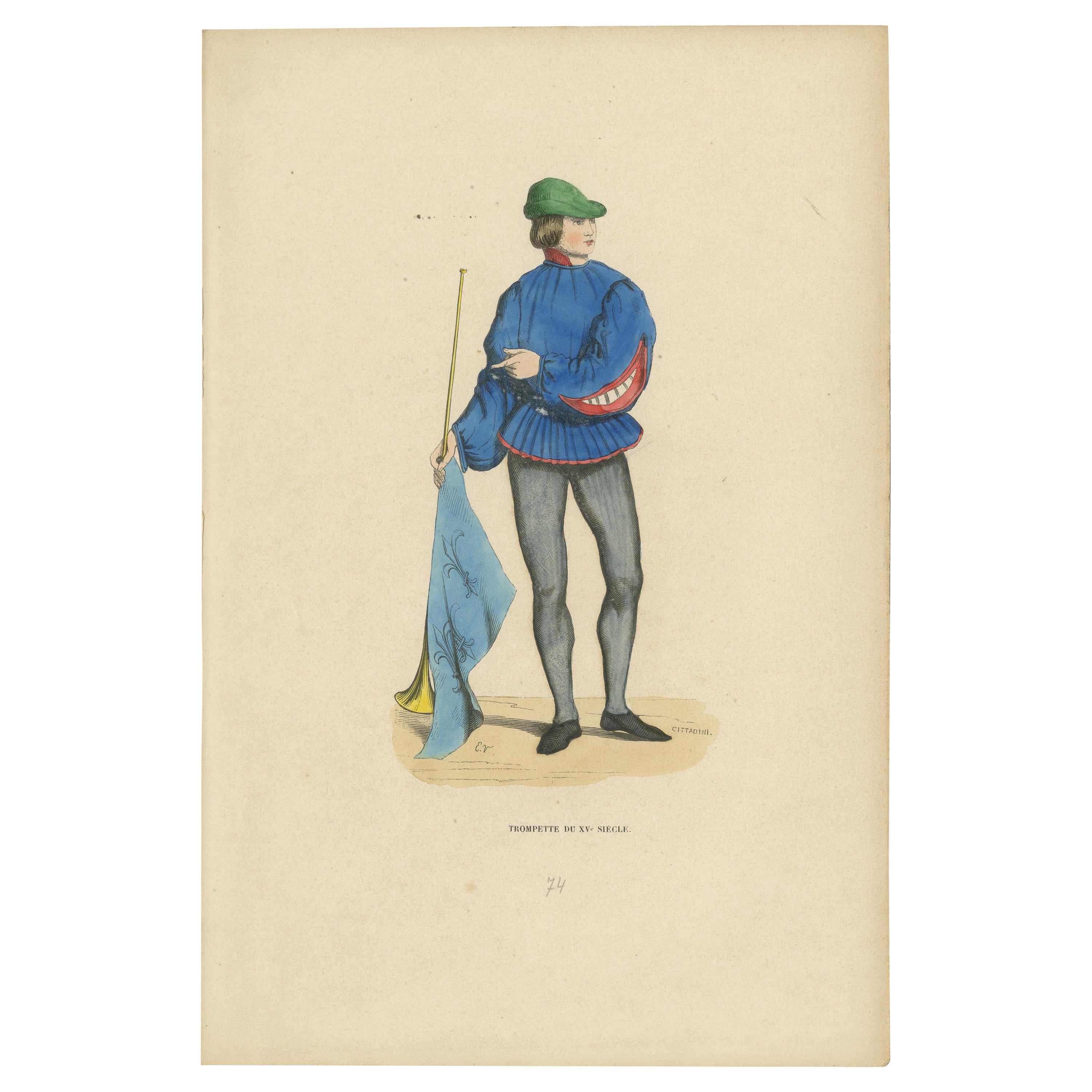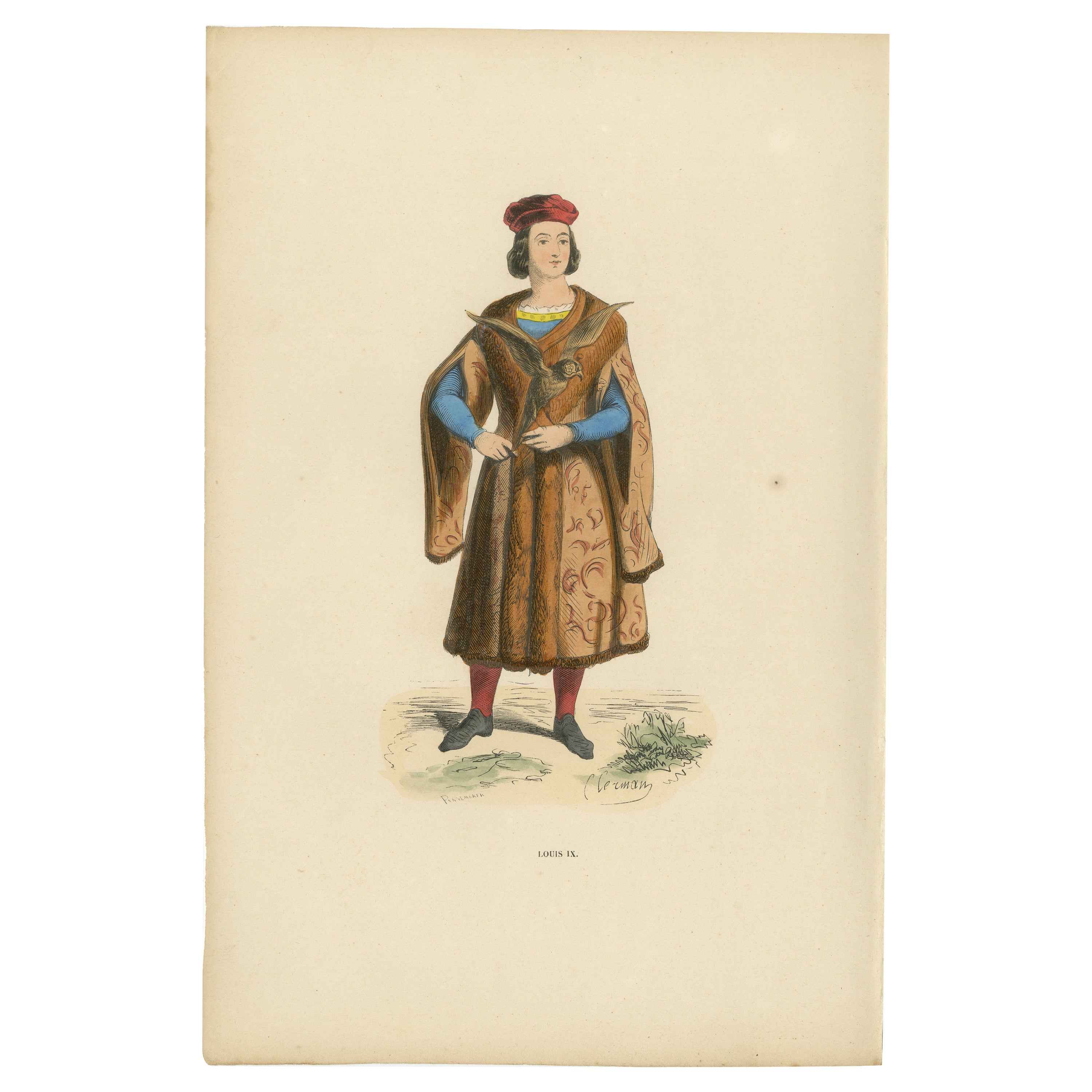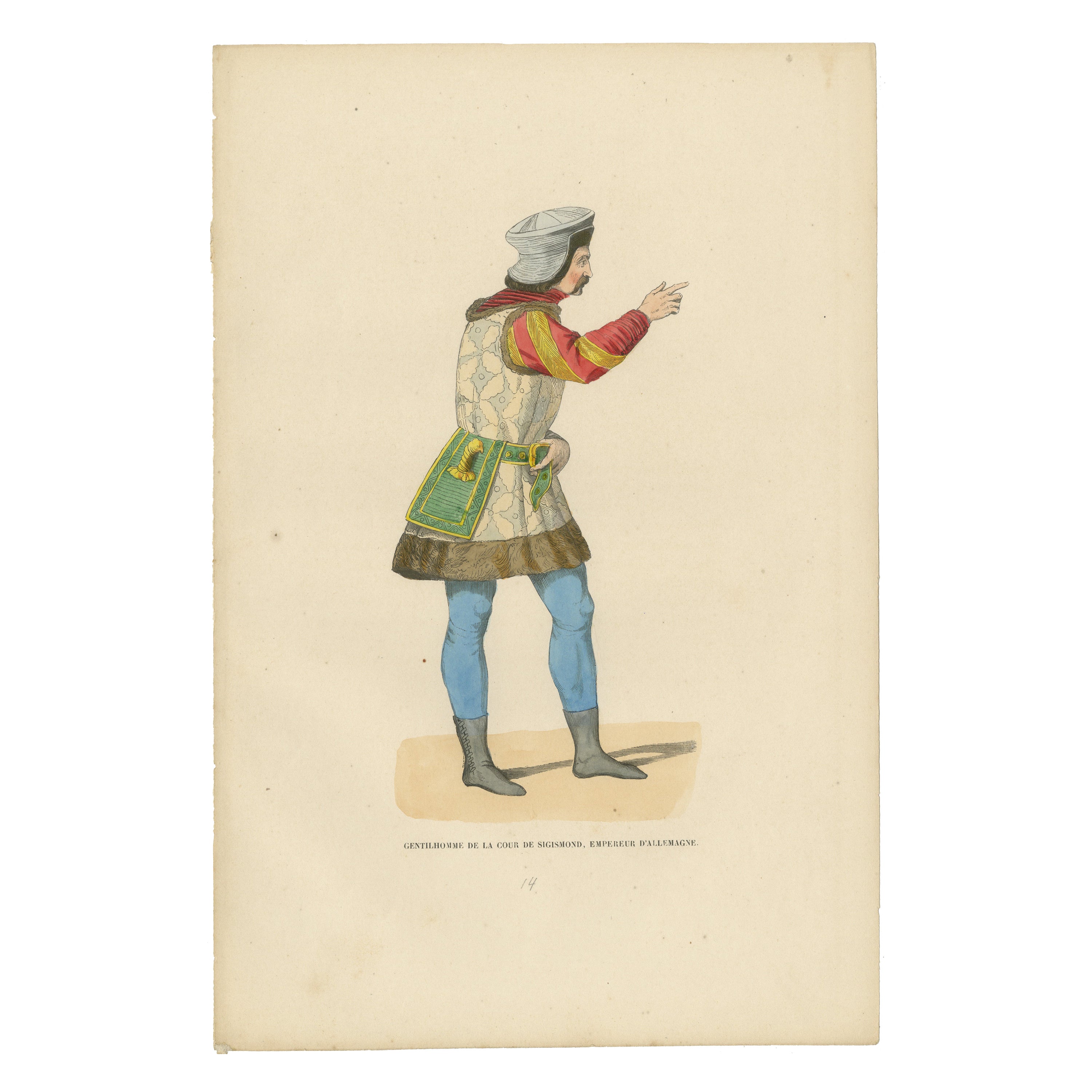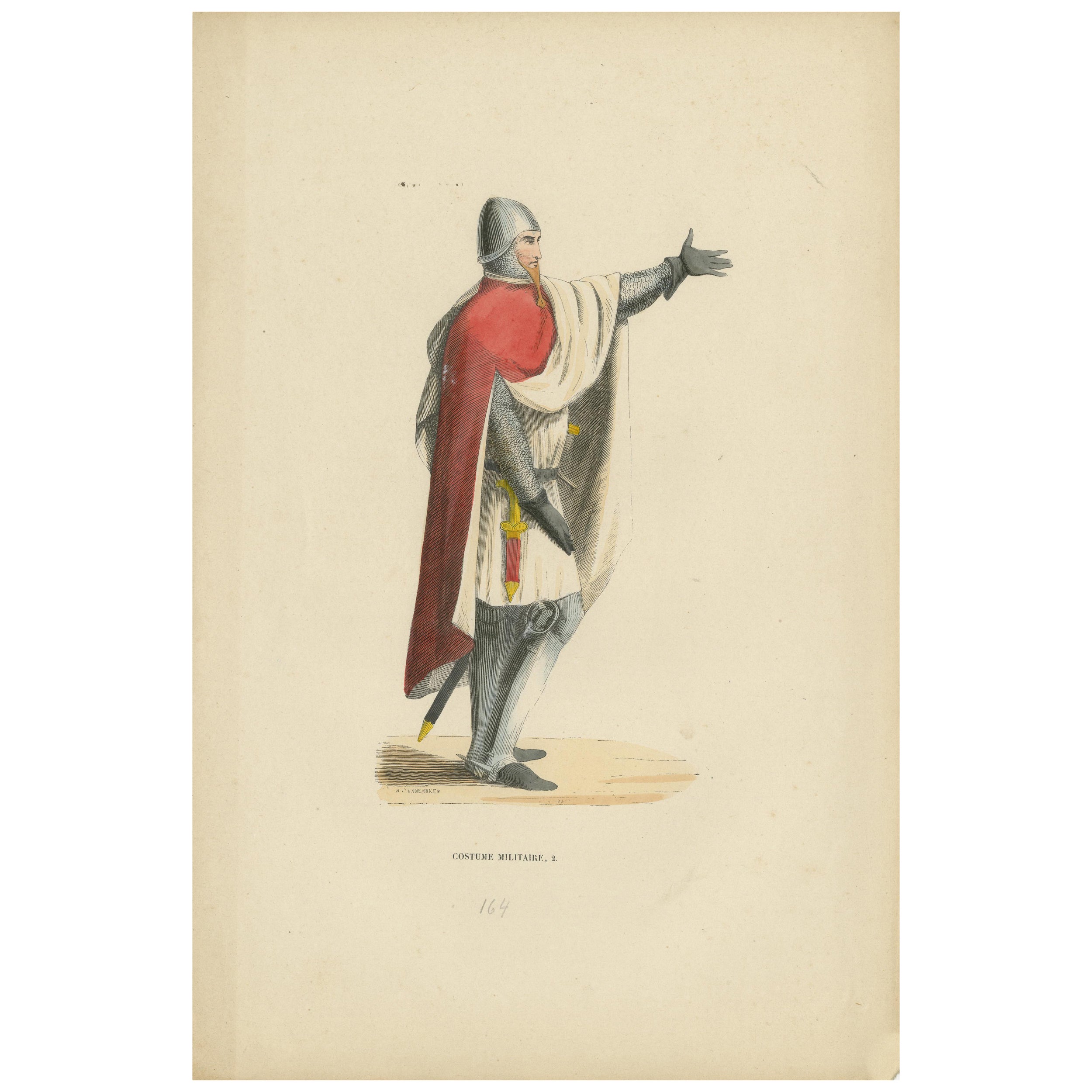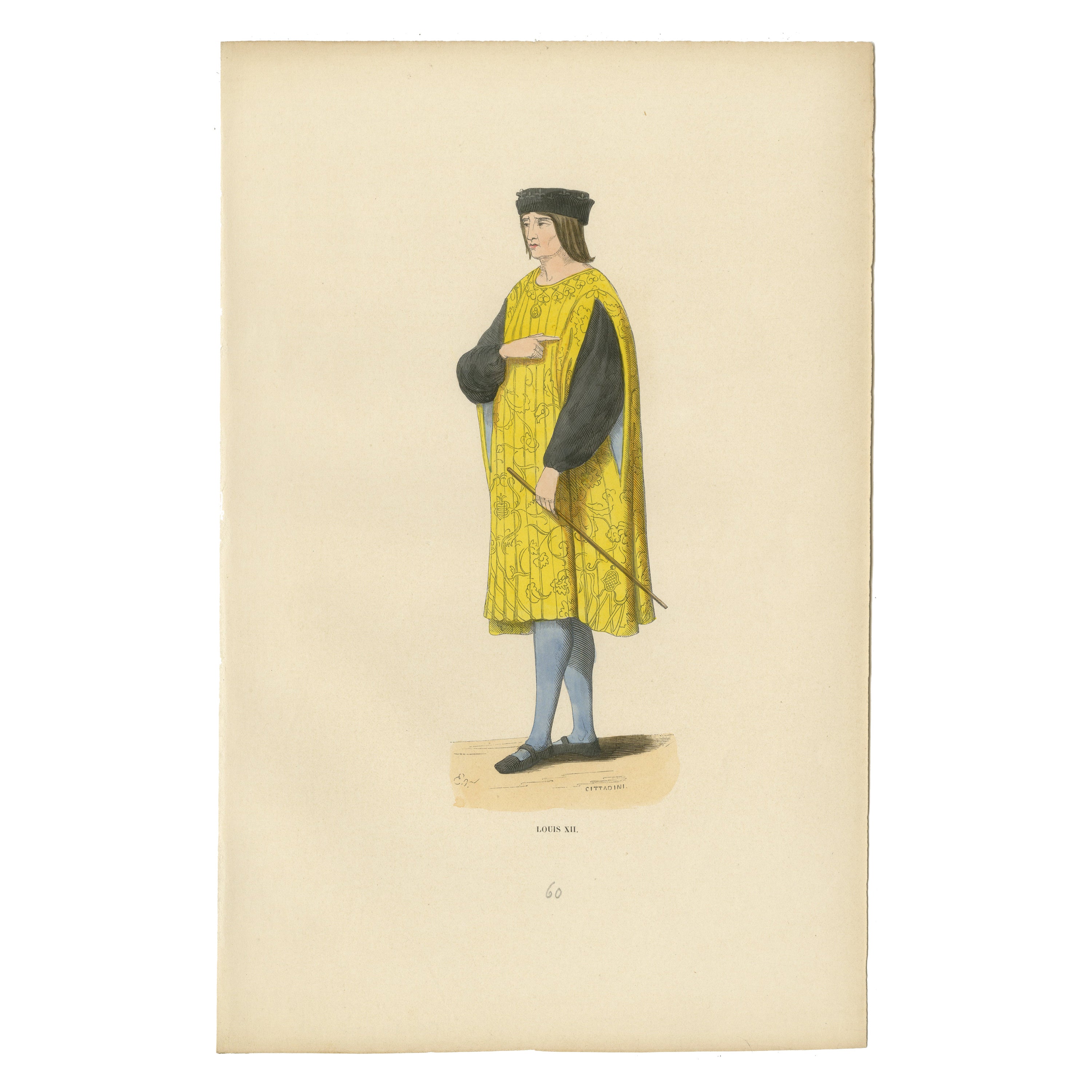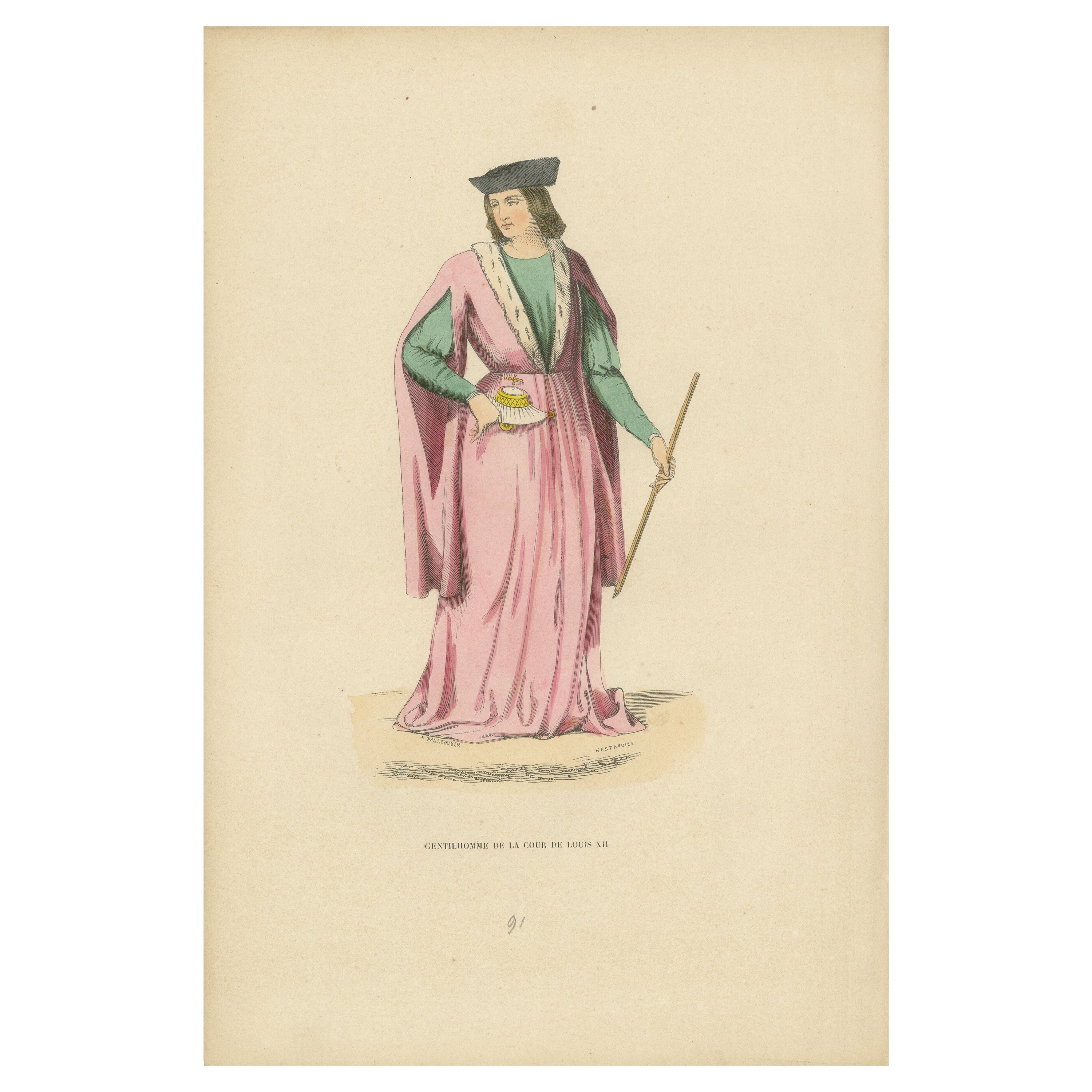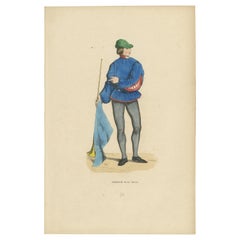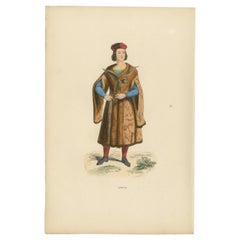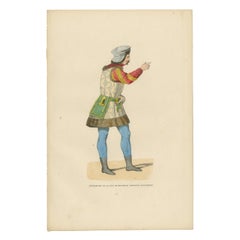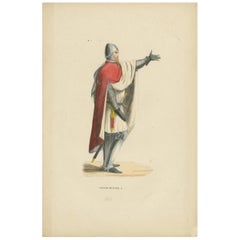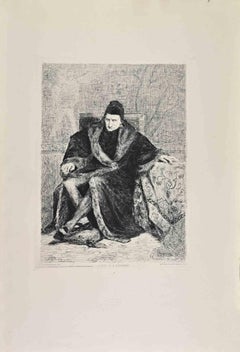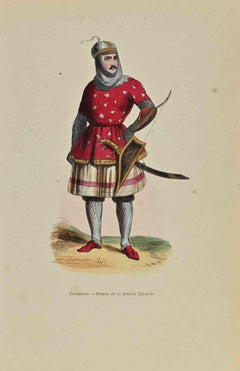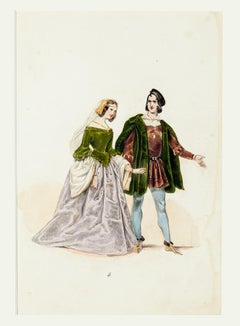Items Similar to Herald Announcing the Death of Charles VI, Published in 1847
Want more images or videos?
Request additional images or videos from the seller
1 of 6
Herald Announcing the Death of Charles VI, Published in 1847
$124.29
$155.3620% Off
£92.01
£115.0120% Off
€104
€13020% Off
CA$171.98
CA$214.9820% Off
A$189.58
A$236.9720% Off
CHF 99.20
CHF 12420% Off
MX$2,326.09
MX$2,907.6120% Off
NOK 1,248.70
NOK 1,560.8720% Off
SEK 1,167.73
SEK 1,459.6620% Off
DKK 791.86
DKK 989.8220% Off
About the Item
Title: "Herald Announcing the Death of Charles VI"
Description: This 1847 hand-colored engraving is titled "Héraut Annonçant la Mort de Charles VI," translating to "Herald Announcing the Death of Charles VI." It depicts a herald, a messenger and officer of arms in medieval times, tasked with conveying important news, in this case, the passing of King Charles VI of France.
The herald is clothed in a short, blue tunic emblazoned with fleur-de-lis, the symbol of the French monarchy, indicating his official capacity in service to the king. The tunic has wide sleeves and is edged with gold trim, suggesting the importance of his role. Underneath, he wears a yellow garment with a checkered hem, which provides a striking contrast to the blue of the tunic.
He wears red hose, a common element of men's fashion during the period, and his shoes are hidden from view, suggesting the focus is on the upper part of his attire, which bears the symbols of his office. The herald's hat is red with a rolled brim, distinctive and easily noticeable, which would help in identifying him amidst a crowd.
In his right hand, he carries a long staff, possibly a symbol of his authority to speak on behalf of the crown. His left hand holds his hat, as if he has just removed it in a gesture of respect or to attract attention before making his announcement. The herald's gaze is downcast, befitting the somber news he bears.
This image provides insight into the historical role of heralds as bearers of news and the regalia associated with their duties in the medieval period.
The colors have a nice glow over them. Historically, egg whites, known as glair, and sometimes egg yolk were indeed used in illumination and painting, particularly in manuscripts, to give colors a brighter appearance and to add a sheen or gloss to the work. This technique was quite common during the Middle Ages and into the Renaissance.
Egg whites can be applied as a varnish over pigments to enhance their brightness and to protect the colors. This application could make the colors appear more vivid and also add a slight glossy sheen to the surface of the image.
Egg yolk, on the other hand, was commonly used as a binding agent in paint. It forms the basis of tempera paint, a medium that was widely used before the advent of oil painting. Egg yolk helps to create a durable and long-lasting color that adheres well to various surfaces.
In the context of the print from 1847, it's less likely that egg whites or yolks were used directly on the print, as by that time, commercial printing processes would have been more advanced and less reliant on such manual methods. However, if this print is a representation of an earlier style or is meant to mimic the appearance of hand-painted manuscripts, the original artists might have employed techniques or materials that gave a similar effect to those achieved with egg-based binders and varnishes.
- Dimensions:Height: 10.63 in (27 cm)Width: 7.09 in (18 cm)Depth: 0 in (0.02 mm)
- Materials and Techniques:
- Period:
- Date of Manufacture:1847
- Condition:Good. Overal light toning and light soiling but the image itself clean and hand-colored almost 200 years ago and still in expliciet colors. Aged paper with typically warm, yellowish-brown hue, mostly around the edges. Study the images carefully.
- Seller Location:Langweer, NL
- Reference Number:Seller: BG-13635-921stDibs: LU3054337906752
About the Seller
5.0
Recognized Seller
These prestigious sellers are industry leaders and represent the highest echelon for item quality and design.
Platinum Seller
Premium sellers with a 4.7+ rating and 24-hour response times
Established in 2009
1stDibs seller since 2017
2,613 sales on 1stDibs
Typical response time: <1 hour
- ShippingRetrieving quote...Shipping from: Langweer, Netherlands
- Return Policy
Authenticity Guarantee
In the unlikely event there’s an issue with an item’s authenticity, contact us within 1 year for a full refund. DetailsMoney-Back Guarantee
If your item is not as described, is damaged in transit, or does not arrive, contact us within 7 days for a full refund. Details24-Hour Cancellation
You have a 24-hour grace period in which to reconsider your purchase, with no questions asked.Vetted Professional Sellers
Our world-class sellers must adhere to strict standards for service and quality, maintaining the integrity of our listings.Price-Match Guarantee
If you find that a seller listed the same item for a lower price elsewhere, we’ll match it.Trusted Global Delivery
Our best-in-class carrier network provides specialized shipping options worldwide, including custom delivery.More From This Seller
View AllRenaissance Herald: The Messenger of News, Engraved, Colored and Published, 1847
Located in Langweer, NL
Title: "Renaissance Herald: The Messenger of News"
Description: This print depicts a trumpeter from the 15th century, known as a herald, who served the crucial role of conveying mes...
Category
Antique 1840s Prints
Materials
Paper
$95 Sale Price
20% Off
Louis IX: A Portrayal of French Royalty in Medieval Attire, Published in 1847
Located in Langweer, NL
The image is a hand-colored engraving titled "Louis IX," representing the 13th-century King of France, also known as Saint Louis, renowned for his Christian zeal and justice. It is p...
Category
Antique 1840s Prints
Materials
Paper
$162 Sale Price
20% Off
Courtly Splendor: A Nobleman at Emperor Sigismund's Court, 1847
Located in Langweer, NL
The image depicts a man identified as a "Gentilhomme de la cour de Sigismond, empereur d'Allemagne," which translates to "Gentleman of the court of Sigismund, Emperor of Germany."
This individual is portrayed in a profile stance, dressed in attire that is indicative of the high-status courtiers during the time of Emperor Sigismund, who reigned in the early 15th century. He is wearing a turban-like headgear, which reflects the influence of Eastern fashion on European court attire, possibly due to the Ottoman influence or the general exchange of culture during the Crusades and subsequent interactions.
His doublet is richly patterned and he has puffed sleeves in red, which were fashionable among the nobility during the period. The garment is accented with a decorative belt that holds what appears to be a purse or a pouch. He also sports tight blue hose and pointed shoes, which complete the ensemble typical of a nobleman or a high-ranking court official in the Holy Roman Empire.
Egg whites can be applied as a varnish over pigments to enhance their brightness and to protect the colors. This application could make the colors appear more vivid and also add a slight glossy sheen to the surface of the image.
Egg yolk, on the other hand, was commonly used as a binding agent in paint. It forms the basis of tempera paint, a medium that was widely used before the advent of oil painting. Egg yolk helps to create a durable and long-lasting color that adheres well to various surfaces.
In the context of the print from 1847, it's less likely that egg whites or yolks were used directly on the print, as by that time, commercial printing processes would have been more advanced and less reliant on such manual methods. However, if this print is a representation of an earlier style or is meant to mimic the appearance of hand-painted manuscripts...
Category
Antique 1840s Prints
Materials
Paper
$152 Sale Price
20% Off
The Medieval Herald: A Portrait of Authority and Message, 1847
Located in Langweer, NL
Title: "The Medieval Herald: A Portrait of Authority and Message"
Description: This print depicts a medieval herald, an essential figure in times of war and peace for communication ...
Category
Antique 1840s Prints
Materials
Paper
$143 Sale Price
20% Off
Louis XII: The Prudent King in Regal Attire, 1847
Located in Langweer, NL
This print presents a dignified portrait of Louis XII, King of France, known for his prudent and just reign. Standing in profile, the king is depicted in royal attire that is both la...
Category
Antique 1840s Prints
Materials
Paper
$143 Sale Price
20% Off
Elegance at the Court of Louis XII: A French Noble's Poise, 1847
Located in Langweer, NL
Title: "Elegance at the Court of Louis XII: A French Noble's Poise"
Description: This delicate historical illustration depicts a French nobleman from the court of King Louis XII, elegantly attired in the fashion of the early 16th century. He stands with a composed and dignified stance, a walking stick in one hand, exuding the grace and refinement expected of someone from his esteemed position.
His attire is a rich blend of colors and textures, indicative of his status. The nobleman wears a soft pink tunic, a color that during the time was often associated with nobility due to the expense of the dye required to produce it. The tunic is complemented by a deep green overcoat...
Category
Antique 1840s Prints
Materials
Paper
$133 Sale Price
20% Off
You May Also Like
Louis XI A Peronne - Etching by Allard Cambray - Late 19th Century
Located in Roma, IT
Louis XI A Peronne is a black and White etching realized by Allard Cambray in the Late 19th Century.
Titled in the lower
Image Size:31x23
Very good impression.
Realized by Cadar...
Category
Late 19th Century Modern Figurative Prints
Materials
Etching
Circus, Prince of the Great Cabarde - Lithograph by Auguste Wahlen - 1844
Located in Roma, IT
Circus, Prince of the Great Cabarde is a lithograph made by Auguste Wahlen in 1844.
Hand colored.
Good condition.
At the center of the artwork is the original title "Circassien , ...
Category
1840s Modern Figurative Prints
Materials
Lithograph
Le Impératrice Eugénie Lithograph, c.1850s
Located in Savannah, GA
A large hand-colored lithograph entitled “Le Impératrice, Compiegne,” after the painting by Jean Victor Adam (1801-1866), circa 1850s. Depicted is the Empress Eugénie de Montijo, wi...
Category
Antique Mid-19th Century French Other Prints
Materials
Glass, Wood, Paper
Ancient Costume - Original Lithograph - Mid 19th Century
Located in Roma, IT
Ancient Costume is an original lithograph hand-colored, realized by an anonymous artist of the XIX century
The state of preservation of the artwork is...
Category
Mid-19th Century Figurative Prints
Materials
Lithograph
c.1830 Exquisite Antique English Etching Artist Proof
Located in Chicago, IL
English etching artist proof. The bottom reads as follows:
Printed by Henry Fradelle and engraved by Thomas Lupton.
Rebecca and Ivanhoe
AS THE WOUNDED KNIGHT WAS ABOUT TO ADDRESS THIS FAIR APPARITION SHE IMPOSED SILENCE BY PLACING HER SLENDER FINGER UPON HER RUBY LIPS...
Category
Antique 19th Century English Romantic Prints
Materials
Paper
20th-Century Graphic – Russel's History of England, King Edmund i Murdered
Located in Opole, PL
We present you one of the fourteen graphics from the series, depicting the history of England.
The graphic is from Russel’s New and Authentic History of England, published in the 18...
Category
Early 20th Century European Prints
Materials
Paper
$191 Sale Price
20% Off
More Ways To Browse
Antique Death
Amethyst Crystal Cut Vase
Amuneal Shelving
Antique 3 Drawer Dresser
Antique Bed Box
Antique Bed Legs
Antique Brass Double Bed
Antique Brass Ladle
Antique Bread Cabinet
Antique Bronze Gong
Antique Butler Pantry
Antique Carved Conch Shell
Antique Carved Stone Vases
Antique Celtic Cross
Antique Cherry Bed
Antique Cherry Secretary
Antique Chest Of Drawers On Wheels
Antique China Buffet
